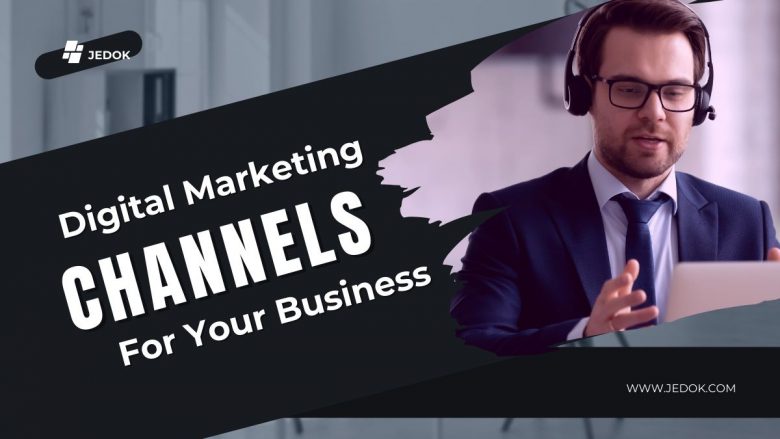
Digital marketing has already made an impact on businesses in a variety of industries. Other than word of mouth, there are numerous ways to connect with customers. Nowadays, thanks to technological advancements, digital marketing channels have paved the way for businesses to become more connected to their customer base.
But where do you even begin?
This essential guide will discuss the various types of digital marketing channels and how to select the best ones for your company:
Different Types of Digital Marketing Channels
When it comes to establishing avenues for your business, there are numerous digital marketing channels to choose from. Just keep in mind that channel results will vary depending on your marketing campaign and industry. That is why, before committing to a particular channel, it is critical to analyze and comprehend your options.
Let’s take a look at how each of the following digital marketing channels works so you can see how they can benefit you and your business:
Social Media
For starters, social media is made up of multiple channels rather than just one. Here are a few examples of social media platforms:
- Facebook is one of the most established social media platforms on the internet. This platform is used by people of all ages for both recreational and professional purposes. Companies, including inexperienced marketers, can benefit from Facebook’s paid advertising tools.
- Twitter’s use of hashtags (#) and keywords is well known. This is excellent for search engine optimization (SEO), a component of organic traffic marketing. Every time you use a hashtag with the right words and phrases on the platform, you’ll attract users who recognize and use that hashtag. Having said that, this platform is ideal for companies with specific niches, as well as industry influencers.
- Instagram is a fantastic platform for sharing images and creating eye-catching advertisements for your business. You can use this platform to post visual content – photos, videos, livestreams, and even attractive (and interactive) advertising – depending on your customer base.
- LinkedIn is widely regarded as the “professional” social media platform. Businesses (including B2B ones) and prospective job seekers can connect through this platform. In turn, job seekers can speak with hiring professionals and agencies, and even post their resume on their personal profile to attract businesses.
Overall, social media marketing is ideal for the following:
- Increasing brand recognition
- Developing stronger customer relationships
- Encouragement of direct sales, IN ADDITION
- Choosing the Right Audience
Organic Search
Users frequently use search engines such as Google. As a result, search engines adapt to accommodate popular keywords and phrases that users enter.
But what if you were aware of the most popular keywords and phrases in your industry? That’s a natural search!
Organic search is a marketing strategy that displays keywords that are relevant to you. All you have to do is type a word or phrase that you believe corresponds to your niche and then let the search engine provide you with a variety of results. You’ll notice recurring keywords and phrases on the first page of the results. As a result, this strategy is inexpensive and can be completed in a matter of minutes online.
Organic lookup for ideal for:
- Increasing website traffic
- Creating relevant links
PPC (Pay-Per-Click) Advertising
Businesses use pay-per-click marketing to… well, pay for more clicks, of course. Essentially, businesses can pay bidding platforms such as Google Adwords to target visitors based on the keywords they select. While this tactic is effective for generating quick responses, it can still result in businesses spending money to “buy” more clicks.
Despite its drawbacks, pay-per-click marketing is ideal for:
- Increasing website traffic
- establishing your company’s authority, AND
- Creating leads and potential investors/donors
Blogging
Even if this method appears to be out of date these days, blogging is still an important component of any content marketing strategy. You can use blogging to share your mission statement, stories, and information about your business and niche. As a result, blogging is ideal for the following purposes:
- Increasing brand recognition
- establishing your company’s authority, AND
- Telling stories about your company
Content Marketing
Content marketing (CM) assists marketing teams in developing a strong online presence and establishing themselves as authorities in their respective niches. All businesses require is a website to get started with content marketing.
The best part about content marketing is that it allows for more creativity. How? By allowing you to create a variety of content. So, in addition to blogging, your company can create some of the following:
- Client and customer case studies, for example.
- Customer feedback
- Download PDF eBooks
- Publications in the press
- Product/Service Contrasts
- Articles on research, etc.
Keeping this in mind, content marketing is ideal for:
- Increasing website traffic
- Developing authority in a specific niche
- Increasing brand recognition
- Consumer education
- Creating leads
- Creating a return on investment (ROI)
- Tell stories about your company.
Direct Emailing
Marketing teams, believe it or not, continue to communicate with customers via email. Emails can still be used in marketing campaigns for everything from newsletters to email confirmations to other important updates. To demonstrate its relevance in today’s marketing, marketers can personalize emails based on the campaign, the consumer, and so on.
In a nutshell, email marketing is ideal for the following:
- Increasing brand recognition
- Developing customer relationships
- Sales management
- Creating leads while also generating ROI
Mobile Marketing
According to Oberlo, there are an estimated 6.4 billion mobile users in the world. That’s a lot of smartphone users!
Companies are now attempting to reach an ever-increasing number of consumers. Companies want to communicate with their customers via text, email, and other mobile devices because many of them are on their smartphones, tablets, and other mobile devices these days.
To achieve the best results in mobile marketing, you must design your website and/or app to be user-friendly. Consider the following:
- User experience (UX) design – how simple it is for users to interact with your website.
- Design of the user interface (UI) – how the site is laid out (its appearance)
- The layout for smartphones, tablets, and other devices
……and so on.
As a result, mobile marketing is excellent for:
- Directing sales
- Generating leads, AND
- Sending your customers instant updates
Choosing The Right Digital Marketing Channels
Choosing the best digital marketing channels begins with a marketing strategy. A marketing plan enables you to work toward incorporating the appropriate channels into your marketing campaigns. The plan includes all of the necessary elements for your marketing venture.
With that in mind, here are some suggestions for selecting the best digital marketing channel(s):
Understand Your Audience
First, determine who your company must serve. That will depend on your product or service, as well as the industry you want to work in.
Then, consider where your target audience spends their time online. Assume you’re in the business of selling cosmetics. Many influencers are using platforms such as Instagram to share makeup tutorial videos for your competitor’s beauty products. Consider posting videos and photos of your product in that case, so that users can begin posting their own media about your brand.
As you can see, knowing and locating your target audience necessitates extensive research.
Make a Goals List
Next, when it comes to digital marketing, take the time to write down your company’s goals. Your goal should already be to get to know your audience. But what about the rest of it?
First and foremost, you will require a set of short-term and long-term objectives. While it is important to consider what your business requires in the short term, you must also consider long-term goals. In other words, where do you see your company in a few years or more as a result of digital marketing?
Make a Budget
Then, you’ll need to create a budget for your digital marketing efforts. Now, depending on the size and popularity of your brand, how big or small your digital marketing efforts will be determined by how much money you have available to invest. Keep in mind that, while you may not want to invest in so many channels, you can prioritize at least one successful channel. For example, if you notice that your company’s Instagram is attracting more users than Facebook, you should prioritize budgeting for Instagram marketing.
Make Use of Talent Acquisition
Finally, consider the members of your marketing team. Do you have any tech-savvy employees? Do you have people who are familiar with social media? Can your team commit to a social media posting schedule? Can your team commit to sending out emails to customers on a regular basis? These are some of the questions you should ask yourself when considering talent acquisition.
Conclusion
Finally, when you use digital marketing channels, your business will thrive. Because technology is already ingrained in the lives of consumers, digital marketing is here to stay.
We hope that this essential guide will assist you in better understanding digital marketing, the different types of channels to consider for your future marketing endeavors, and how to make it work for you. We hope that this guide will assist you in reaching out to more customers.
Best wishes for your marketing endeavors!
Learn more from Marketing and read Large Format Printing and Its Uses in Marketing.


